CGS Sculpture Artist: Nyssa Collins and Carson Whitmore
Arts Everywhere teamed up with the Center for Galapagos Studies (CGS) to call for proposals for sculptures in honor of the 10th anniversary of the Center for Galapagos Studies. Four artists were selected to create a piece of human-sized art (4-7 feet) with recycled and sustainable materials that represent and celebrate the wildlife of the Galapagos Islands.
Learn more about Nyssa Collins and Carson Whitmore, one of the four artist teams chosen for the CGS Sculpture project, and their sculpture of a marine iguana!
About the Artists
Tell us a little bit about yourself and your artistic journey.
Carson: My work as a farmer and carpenter greatly influenced my creative practice. I am intrigued by repetitive processes and material records of labor, and most recently have been exploring quilting as an entry point for my explorations. There are rich connections between sewing/quilting and constructions that I am continuing to discover. This project has utilized some of these skills in being resourceful and thoughtful with limited/recycled material for the construction of the armature. The design element of piecing a quilt top has resonance with the mosaic element of our sculpture.

Nyssa: In college, while studying piano, I taught myself to paint on the bedroom floor of various rental houses across Northern California. I am originally from Alamance County, and returned home for the job of a lifetime – building puppets and performing with Paperhand Puppet Intervention. For the last five years my artistic practice has exploded in many experimental directions – cardboard sculpture, shadow puppetry, building with trash, and illustration. I am most interested in art that can be played with or performed, and art that leaves people with a warm feeling in their belly.
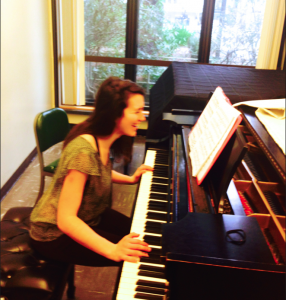
Who or what are your inspirations?
Carson: I am very inspired by people who are self taught in their field–true “amateurs” who engage in a practice because of a genuine love of something. Lately I have been very interested in the work of Llyod Kahn, builder and amateur historian/archivist of small-scale, handbuilt homes and homesteads. I’m intrigued by the optimisms, successes, failures, and changing notions of the “back to the land movement” of the 1970s that Kahn is/was a part of.

Nyssa: I am greatly inspired by Jan Burger and Donovan Zimmerman of Paperhand Puppet Intervention, my mentors for the last five years. They have taught me that creating art with a community has this incredible effect of exponentially increasing its magic. I am also very inspired by the experimental work of Chicago-based Manual Cinema, which uses old techniques to tell extremely modern stories; they are always reinventing themselves!

One word to describe your art
Carson: Obsessive

Nyssa: Charismatic
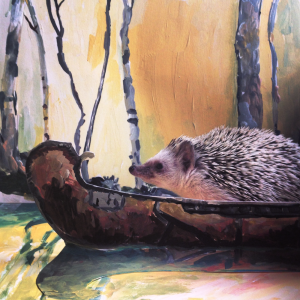
Favorite place you’ve traveled to or somewhere you’d like to go?
Carson: I had the very fortunate experience of spending two months in the Galapagos– truly an incredible trip and full of many unexpected experiences (and of course, a factor in taking on this project). Snorkeling amongst marine iguanas was one of many memorable experiences.
Nyssa: I spent a wonderful month in the Patagonia of Chile through a residency via workaway.com. I played piano for a tiny music school just as spring was melting all the ice into miniature waterfalls in every direction. I dream every day of going back to write a puppet show with the community!!
What’s your dream project?
Carson: I am very fascinated with trash! I would absolutely love to be an artist-in-residence at the landfill.

Nyssa: I just want to rent a vacant storefront in a strip mall and fabricate puppets and performances – every single one of them is totally different!
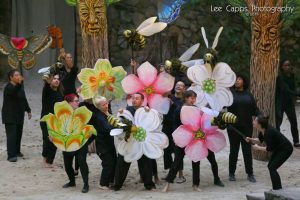
How did the Carson-Nyssa team/collaboration come about?
Carson: We are in each other’s orbit as artists who both transform our homes into exhibition and performance spaces: puppet shows, DIY house concerts, large-scale quilt installations, parades, etc. Our combined skills and experience in carpentry, puppetry, sculpture, and personal experience having traveled to the Galapagos felt like a natural fit for an artist team.
Nyssa: I am super into Carson’s experimentalism and her industry. I have admired her working style for a long time, because she is always making something, and her work goes through brand new phases all the time. Although Carson trends toward abstract art and I seem to prefer things with faces, I really think our work complements each other; we are both huge experimenters, love scrappy materials and going in with screwdrivers and saws, and are deeply charmed by the cycles of the natural world.
On the CGS Sculpture Project
Sculpture info
- Title: Marine Iguana (Foraged Matter)
- Description: Unique to the Galapagos Archipelago, the marine iguana is the only species of lizard marine lizard in the world. Foraging for algae in sea water, the marine iguana is vulnerable to plastic pollution and microplastics that continue to pervade this fragile ecosystem. Our sculpture makes use of plastics to both emulate the marine iguana’s distinctive coloring and highlight the impact of the human footprint on the Galapagos Islands.
What drew you both to apply for The Center for Galapagos Studies Sculpture project?
The opportunity to apply our skills in new ways sounded like an exciting stepping stone to further our creative practice. We both build large scale things for our work, and it’s always fun to make something big!
Tell us which animal you two choose and why.
We chose a marine iguana: we were drawn to their unique coloration and felt like a marine iguana’s scales were a great fit for the mosaic technique we wanted to use

What sustainable and recycled materials did you use?
Much of the frame is built with recycled material that I (Carson) had scrapped from a building project. The mosaic incorporates plastic pieces that are part of our waste stream. We also scavenged/thrifted lots of found objects- broken mirrors, keys, and North Carolina quartz.
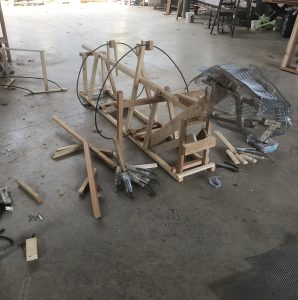
How do you hope the community will engage with your piece?
We hope that people will, firstly, get to know what a marine iguana is–probably many people do not know of this charismatic creature! We also hope that people will be inspired to consider their usage of plastics by engaging with our sculpture.
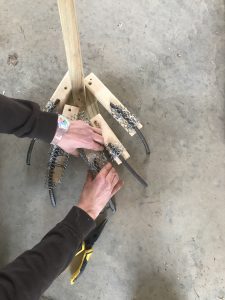
What’s your favorite aspect of the sculpture?
As we’ve been building the frame, our iguana has become more animated and lively than our original sketches. It has become a dynamic creature before our eyes, and even startled us with being so lifelike! I (Nyssa) also love that the project incorporates different elements: the sculpture has been a delightful exercise in form and expression, and the mosaic adds a new element of being playful with color.
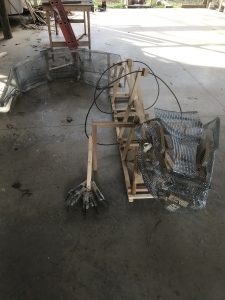
In your proposal you mentioned your interest in approaching art-making as a tool for research and information-gathering. What can you share with us about what you learned?
We’ve been gaining more experience and knowledge of material for our project–and have enjoyed that this has come about through the building process, rather than separate from it. Specifically, we’re working with materials often associated with construction. Almost 40% of waste is construction waste, a fact that gives us pause. Making use of scrap materials requires creativity and ingenuity, as the building process is dictated by what is available. Our project, though very small scale, is an exploration of the resourcefulness, material engagement, and thoughtful pace required to “make do” with recycled material.
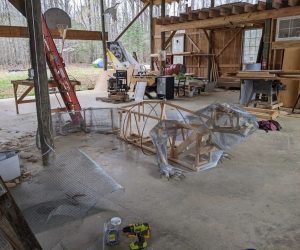
View Nyssa and Carson’s rendition of a marine iguana in front of the Morehead Planetarium (specific location on Google Maps)! Be sure to look for the other three pieces as part of this project outside the FedEx Global Education Center, The Arboretum and the Campus Y.
All photos are courtesy of Nyssa Collins and Carson Whitmore. To learn more about Nyssa, visit nyssacollins.com or check out her Instagram, @nizmoco! To learn more about Carson, visit carsonwhitmore.com or check out her Instagram, cool_._weather!